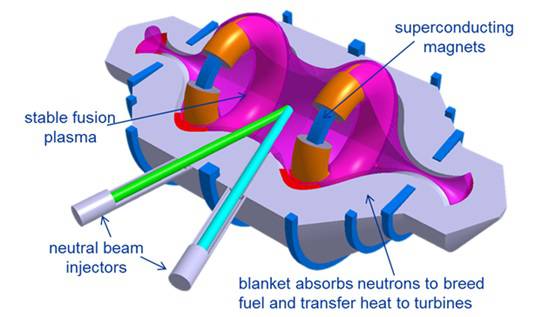October 17, 2014 – In the world of fusion power we have an ongoing technology race between cold and hot fusion. Where traditional science sees cold fusion with dubious eyes, the investment in hot fusion research has been multiple billions of dollars with no commercial end result after several decades. So in a week when the latest paper reveals results of testing of a LENR cold fusion device, an announcement of a pending hot fusion device that could go commercial within the decade is being seen with jaundiced eye. Of course the difference between the two fusion announcements is the latter is backed by a company that generates $45 billion US in annual revenue.
The company, Lockheed Martin, engages a skunk works team working on energy projects. And in the last few days that team has revealed the work it is doing on a commercial hot fusion reactor technology that is a tenth the size of the tokamak-designed ITER project in France. It literally will fit on the back of a truck.
They call the device a CFR, standing for compact fusion reactor and they expect to have one ready for testing within a year, a reactor prototype ready in five, and the first full production commercial product in ten. In a video on YouTube, Thomas McGuire, a graduate of MIT and lead in Lockheed Martin’s Skunk Works Revolutionary Technology Program, describes his vision for the CFR, a technology that will replace conventional power generation and help humanity deal with climate change. CFRs will operate in power plants and even will be used in airplanes where they will make it possible to stay aloft for long periods without landing to refuel.
So how does a CFR work? Like the ITER project, the energy of the Sun when created here on Earth must be put in a bottle. In both the ITER and CFR that bottle is magnetic. One difference is scale. The ITER is the size of a building. The CFR is no bigger than the bed on the back of a semitrailer. Another difference is the vessel design itself which is the secret behind the confident declaration of the Skunk Works team.
In the CFR a gas containing deuterium and tritium provides the fuel. Both of these elements, hydrogen isotopes, are readily available here on Earth. The deuterium-tritium gas gets injected into the compact containment vessel. Energy is applied causing the gases to form a plasma which is contained by a magnetic field. The tight containment concentrates the ions and electrons which ten collide and fuse. Fusion releases lots of energy and helium-4, the latter useful for medical, chemistry, space and the creation of super-fluids. The energy heats the reactor walls which are surrounded by conventional heat exchangers. It is this heat that can then be used to drive turbines to generate power. There is no radioactive waste
The initial prototype when finished will only run for ten seconds but it will generate much more power output than the energy input. A truck-sized CFR, 7 by 13 meters (23 by 43 feet) will have the capacity to generate 100 Megawatts of power. That’s enough energy to power 18,000 American homes.
It all sounds incredible and you would think that Lockheed Martin would be moving ahead on their own to make the CFR a reality. But instead the company is seeking partners to put money into the project. Talk about hedging your bets. Maybe this isn’t the sure thing that McGuire describes with confidence in the video. But if it is then talk about a game changer for the planet.



















